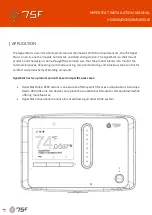
FSD-C Damper Installation, Operating &
Maintenance Instructions
1 Health and Safety
1.1
Only competent personnel may carry out the work outlined in this document.
1.2
Wear appropriate Personal Protective Equipment as required for safe working
conditions and as site rules dictate.
1.3
Do not introduce fingers across the open blade.
1.4
Where dampers are only accessible with the need for additional elevation, any
equipment used should be done so with due consideration to the Work at
Height regulations 2005 and current site rules.
2 Important
2.1
These instructions should be read in its entirety before commencing work. The
installer must be Competent with the manufacturer’s separating element
construction.
2.2
PML Actuators are IP54 rated – Check actuator connection box is suitably
located.
2.3
Do not cut/shorten the Thermal Fuse lead (-TF Actuators). This will render the
unit inoperable and invalidate the warranty.
2.4
Refer to actuator label for wiring of actuator.
2.5
Refer to section 10 for testing.
2.6
For existing dry walls – When cutting the opening for damper, and (partial)
removal of stud is unavoidable, ensure the structure is sufficiently supported
to conform to design specification
2.7
Dry wall openings must be lined.
2.8
Ensure that appropriate ‘fire-rated’ plasterboard is used throughout the
construction of drywall partitions that need to act as fire-barriers.
2.9
Ductwork to be fitted and connected in accordance with DW 144/145.
Aluminum rivets should be used (to act as breakaway joint).
2.10 All installations are subject to local Building Control Approval (BCA). Tested
Installations are detailed herein. If the proposed installation has minor
variations to that shown, acceptance from BCA should be sought before
proceeding. Manufacturers are not able to ‘approve’ specific installation
methods.
3 Equipment required
3.1
Equipment and tools will vary dependent upon the fire barrier construction that
the damper is being installed within. Standard equipment that are normally
used for the building of the particular barrier should suffice. Access-equipment
as necessary.
3.2
8mm, 10mm for motor fixing and 12mm AF spanners to change blade position
via drive shaft. Phillips №2 screwdriver for setting of OPEN position if required.
3.3
Cordless drill
3.4
Screwdriver to suit junction box terminals.
4 Preparation for Installation
4.1
Before installation, the damper should be inspected to ensure that it has not been
damaged and is in good condition following transportation/on site storage.
4.2
Check damper reference and size to site specification.
4.3
Install damper to site specification details and building codes of practice. (Refer
to Tested Installation Methods). Non-tested installations may be rejected by
building control.
4.4
Ensure that the ductwork is independently and adequately supported.
4.5
Connecting ductwork should be connected with breakaway fixings such as
aluminium rivets in accordance with DW144 and 145.
4.6
Note: All Fire / Smoke Damper installations must be carried out to the satisfaction
of the appropriate Building Control officer and/or specifying authority. Where
more than one duct penetrates a wall or floor, adjacent fire damper assemblies
should be separated by a structural element with a minimum width of 200mm
(to comply with BS EN1366-2 13.6).
4.7
Test damper (Refer to section 10)
Tested Installation Methods
5 Preparation
5.1
The installation method contained herein assumes the wall has been built prior
to the damper opening preparation.
5.2
Determine required position of damper. Check sufficient space exists to fit the
product. Ensure any services (e.g. electrical/plumbing) within the structure or
running close to the structure will not be affected. If existing stud/track is
avoidable, ensure the structure is sufficiently supported to conform to design
specification and that the opening is lined.
5.3
When the structure is deeper than the casing length it may be necessary to
connect ducting to the non-access side of the damper through the opening,
before final fitting the damper. Once this is done slide the damper and
ductwork assembly back through the opening until the Installation Plate butts
up to the structural surface ready to be fixed.
6 Procedure
Dry wall Installation
6.1
Preferably, prepare opening whilst building wall, or cut opening if wall already
exists.











